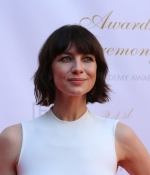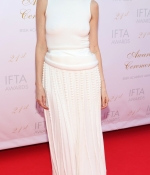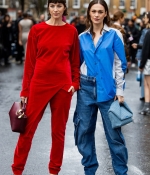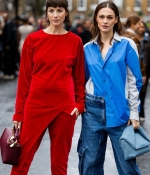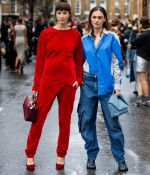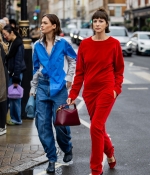In Kenneth Branagh’s evocative, semi-autobiographical drama Belfast, Caitriona Balfe plays a resilient but increasingly scared woman facing an impossible choice. Named in the script only as Ma, Balfe’s character is the matriarch of a working class Protestant family in 1960s Northern Ireland, whose day-to-day existence becomes increasingly dangerous amidst The Troubles. With her husband (Jamie Dornan) often overseas for work, Ma is usually left to parent their two young sons, Will (Lewis McAskie) and Buddy (Jude Hill), alone, and as the environment becomes more and more unstable, she’s forced to consider uprooting the family altogether and fleeing to England.
“The script was so emotional, and it was really evocative. Even though it’s very much Ken’s story, I was sobbing by the end of it as somebody who’s left Ireland, as somebody who grew up in a very big family, and I’m now away from them,” Balfe told ELLE.com on Zoom last month. “There was also just the tragedy of what I know went on in Northern Ireland. I think there’s something about seeing the world through the eyes of a child, and [Branagh] has really perfectly captured what it’s like to see the world at that age,” she added, referring to nine-year-old protagonist Buddy. “There’s a myriad of things that can happen to us where we have this loss of innocence, and I think that’s something that everybody can relate to in one way or another.”
Below, Balfe, who just earned a Golden Globe nomination for her performance, delves into how she and Dornan bonded on the Belfast set, her experience of filming Outlander season 6 while pregnant with her first child, and the key difference between Ma and Outlander’s Claire.
The marriage between your and Jamie Dornan’s characters in Belfast is seen mostly through glimpses, or snatches of conversation that their son overhears. What was the experience like of creating that dynamic?
Jamie and I didn’t really know each other before this. We’d met once, I think, through a mutual friend. So one of the first days, Ken had us all sit down in a room, Judi [Dench], Ciarán [Hinds], Jamie, and myself. We shared just a lot of information about our childhoods, our parents, our grandparents…Ken’s brilliant, he has these Wizard of Oz ways of getting people to be at the right place to get what he needs to get from them. So from that first day, I knew more things about Jamie than probably someone who’s known him four or five years or 10 years might have known—personal, vulnerable things, and him likewise, the same with me. So we started off from a very open place with each other.
Then, the next thing we had to do was dance. So we had a dance rehearsal, and that’s also something that’s very, I don’t know, I suppose exposing, and makes you very vulnerable. So very quickly, we just had this very cool bond with each other and everything else just built organically from that. I think we both approach our work in a very similar way. We both are very meticulous about our preparation, but then very easy with how we are on set. I think we both try to be uncomplicated with how we work, and just show up ready to play and not have to make too big a deal of it, if that makes sense. That was really freeing.
Was there any particular scene that you felt helped you to understand your character?
I don’t think it made it into the film, but there’s a little moment where Buddy’s asking about why he has to go to church, and he’s like, “Well, why aren’t you going?” Ma says, “Me and your father have some business to discuss, and God understands.” In the script, there’s a shot as Buddy and Will are walking away where you see the upstairs curtain close, and it’s obviously Mum and Dad are having a little bit of fun time! It was knowing that no matter what the tensions were, they still had a vibrant sex life, and they were still very much in love with each other. That was a really helpful thing to know.
So you knew where you were pitching things, that even though they were battling and banging heads, it wasn’t the sum of their whole relationship. That there was light and dark, there was up and down, and that that was always very present together, running alongside each other. But I do love scenes where you also get to just have explosions, and as a fiery Irish woman, I understand! I don’t think I quite throw plates, but I might have a bark. Having scenes where you can just let loose and throw a few plates at somebody is just really great fun.
Speaking of fiery women, I was thinking about Ma in relation to Outlander’s Claire Fraser. It just struck me that you’re playing these women who have to be very centered, and try to hold their family units, in the midst of enormous trauma and upheaval.
In a way, yes, they share that in common, but what really makes them different is I think Claire thrives on the unknown, and is forging her way through that by going forward. Whereas Ma, I think, at her core, there’s such a scared little girl that can’t really imagine a world beyond this little space that she knows so well. She’s like a big fish in a small pond, but she can’t really conceptualize life beyond that, and I think that’s her struggle. For her to be able to get to the point where she can make a decision to leave was really, really difficult, because I don’t think she had the confidence to veer past or to step outside this world that she knows so well. Which is very different, I think, from Claire. Claire has a lot of innate confidence in her capabilities. Whereas I think Ma, because of her upbringing and because of her surroundings, was very limited in that way, and that was really interesting to play.
That’s a good point. Claire really thrives on throwing herself outside of the world she knows.
Yeah, Ma is clinging on dearly to the only world she’s ever known, and I think that’s very telling. We get to see Pa’s parents, and we get a sense of the stable background that he’s come from. Whereas Ma, you never hear about her parents. You never see them, and so she never had that grounding and that stability at home from a young age. So for her, she’s clinging on to the only home and stable life that she’s ever really known, and that’s why it’s so hard for her, I think, to make that decision.
Outlander season 5 ended on a very traumatic note for Claire, and it sounds like things aren’t necessarily going to get easier. What can we expect from season 6?
The events of the end of season 5 have really destabilized Claire in a way that we’ve never seen before. I think Claire has always been able to compartmentalize things and move on, with that very 1940s can-do attitude. She packs things up in a little box, she parks it, and she gets on with the rest of her life. And we see that she’s unable to use that coping mechanism, to get through this particular incident. So it’s really lovely to actually finally unpick her in a way, and find her core vulnerabilities. I think it’s the only way she can properly heal, because she has to find a new way of coping. She has to find a new way through. There’s really great stuff for Claire this season. We’ve got some great directors back, and I think we’re playing around again with the style of the show, so that’s really exciting.
And I believe you were also pregnant throughout filming, right?
Pregnant for the entire season, yeah! I could’ve probably timed things a little better. [Laughs] But these things happen when they do. I was pregnant, there was COVID, it was winter, shooting every single day for 14-hour days…it wasn’t the easiest six months, but it was good. I have to say, our camera crew, in particular, a bunch of burly Scottish men, were the sweetest group and really looked after me. They’ve all become dads, I think, since we started shooting way back in season 1, and I’ve never had so much child-rearing advice or pregnancy advice or baby gear advice as I have from all of them, and it was just brilliant. They’re legends, all of them, so a big thank you to them.
So 2021’s been a pretty huge year for you, and you’re capping it off with all this Oscar buzz for Belfast!
Yeah, all that stuff’s a bit, like, aargh! But it is exciting. It’s exciting for Ken because this is such a personal film for him. He put so much of himself in it, and he has created this merry band of warriors around him, and I think we all just feel a debt of gratitude that we got to go on this journey with him. So I think we all just feel very happy for him that it’s getting such a good response.
Source

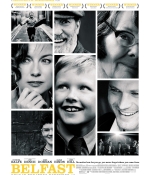




 As a child, Caitríona Balfe never found it strange when a trip to the dentist or to a clothing store involved driving by British soldiers with machine guns, or having the family car inspected for explosives. There were frequent bomb scares too, around where she grew up in Tydavnet, a small Irish village near the Northern Ireland border, and sometimes on the news she’d hear about a nearby community that had been hit. “It’s such a part of the fabric of your life when you live in those areas,” she says. “It’s really not until you get older that you look back and you realize the craziness of it, or the strangeness of it.”
As a child, Caitríona Balfe never found it strange when a trip to the dentist or to a clothing store involved driving by British soldiers with machine guns, or having the family car inspected for explosives. There were frequent bomb scares too, around where she grew up in Tydavnet, a small Irish village near the Northern Ireland border, and sometimes on the news she’d hear about a nearby community that had been hit. “It’s such a part of the fabric of your life when you live in those areas,” she says. “It’s really not until you get older that you look back and you realize the craziness of it, or the strangeness of it.”

